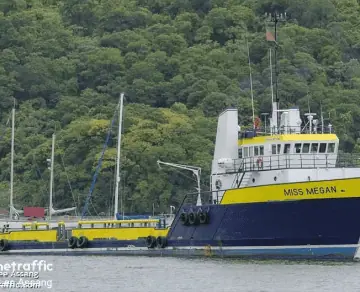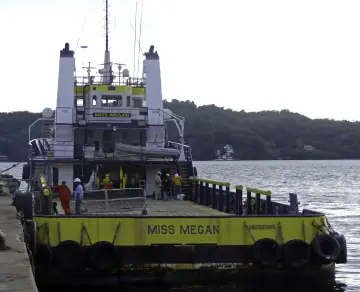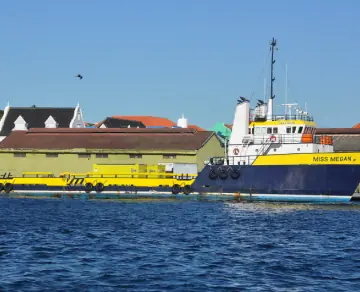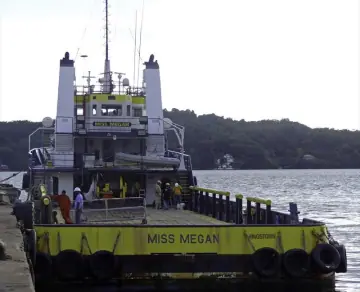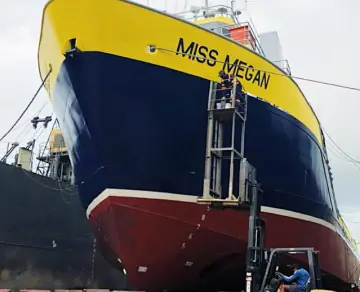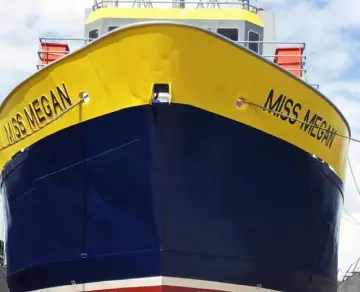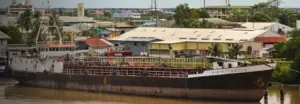Vessel
MISS MEGAN
Services performed
Hull cleaning, Painting, Structural repairs, Propeller, Valve servicing
Duration
October 26, 2021 to November 2, 2021
Ship type
Offshore Support Vessel
Overview
The vessel MISS MEGAN was dry-docked at our facility for essential maintenance and repair work from October 26, 2021, to November 2, 2021. The project encompassed hull cleaning and painting, structural repairs, propeller and valve servicing, and other critical activities to ensure the vessel’s optimal performance and seaworthiness. Below is a detailed overview of the work completed during the drydocking period
Hull Maintenance and Painting
High-Pressure Washing
The hull of the vessel was thoroughly cleaned using a high-pressure washer set at 4500 psi, covering an area of 628.47 square meters from the keel to the waterline. This step was crucial for removing marine growth, dirt, and other contaminants, providing a clean surface for subsequent treatments.
Sand Sweeping and Blasting
The hull was sand-swept from the keel to the bulwarks, including blasting all corroded areas to a cleanliness level of SA 3.0 (white metal). Beveled edges were also treated, covering an area of 827.04 square meters. This process ensured the removal of rust and scale, creating a pristine surface for painting.
Painting
The entire hull was painted with four coats from the keel to the waterline, covering an area of 2,100 square meters (525 sqm x 4). From the waterline to the top of the bulwarks, two coats were applied, covering 604.08 square meters (302.04 sqm x 2). This thorough application of protective coatings is essential for preventing corrosion and enhancing the vessel’s longevity.
Additional painting tasks included repainting the draught marks (four areas), vessel name (three areas), Plimsoll marks (two areas), port of registry (one area), and bow thruster marks (two areas). These markings are vital for regulatory compliance and operational safety
Deck and Sea Chest Maintenance
Deck Maintenance
The main deck, forecastle deck, and internal bulwarks were sand-swept and blasted to SA 3.0 (white metal) to remove corrosion and prepare the surfaces for painting. The area covered was 457.82 square meters. Two coats of paint were then applied, providing 915.64 square meters of protection.
The deck wood was removed to facilitate the sand sweeping and painting process and then reinstalled to ensure a seamless and durable finish
Sea Chest and Bow Thruster Maintenance:
Two sea chest grids were opened, cleaned, power brushed, and painted with four coats of protective paint, ensuring the sea chest’s efficiency and longevity. The bow thruster tunnel was similarly cleaned, power brushed, and painted to maintain optimal performance.
Propeller, Valve, and Structural Repairs
Propeller and Shaft Work
Both the port and starboard side propellers were removed, serviced, and replaced, including securing the shaft nuts. The propeller shafts were also removed and replaced. Precision work was carried out on the portside propeller blade, including applying heat to straighten it and repairing the keyway.
Two propeller nuts and two coupling nuts were manufactured to fit the propeller shaft as per the specified requirements. Additionally, one key was manufactured to fit into the propeller shaft and propeller, and two packing glands were produced to meet the specifications.
Valve Servicing
Two sea chest valves were removed, serviced, and reinstalled to ensure the proper functioning of the vessel’s cooling and ballast systems.
Structural Hull Repairs
A section of the hull on the port side, at the bottom of the engine room, measuring 25” x 16”, was cropped and replaced to restore the integrity of the vessel’s structure. This was a critical repair, addressing areas of significant wear and ensuring the vessel’s seaworthiness.
Additional Repairs and Maintenance
The vent pipes and lifting zones on the main deck were repainted to maintain their visibility and functionality. The mud tank was cleaned, pressure washed, and all debris was removed, ensuring the tank’s efficient operation.
Bumper tyres were removed, pressure washed, and replaced to protect the vessel’s hull during docking and undocking operations
Ultrasonic Testing
Hull Integrity Testing
The hull of the vessel underwent ultrasonic testing by an approved surveyor. This non-destructive testing method was used to assess the thickness and integrity of the hull plating, ensuring that the vessel met all safety and regulatory standards.
Client Testimonial
“The hull of the vessel underwent ultrasonic testing by an approved surveyor. This non-destructive testing method was used to assess the thickness and integrity of the hull plating, ensuring that the vessel met all safety and regulatory standards.”
Name Last
Client
Gallery
